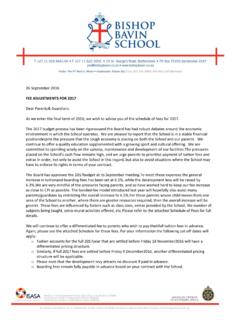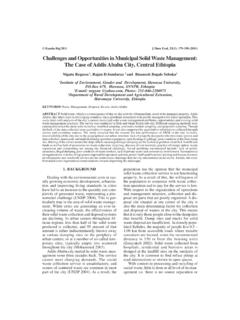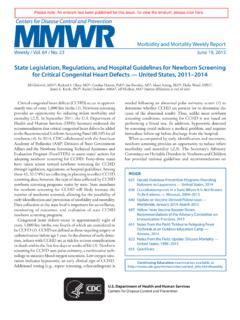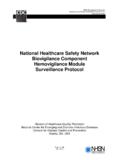Transcription of GC-MS: Principle, Technique and its application in Food ...
1 INT J CURR SCI 2014, 13: E 116-126 REVIEW ARTICLE ISSN 2250-1770 GC-MS: Principle, Technique and its application in Food Science Syed Zameer Hussain* and Khushnuma Maqbool Division of Post Harvest Technology, Sher-e-Kashmir University of Agricultural Science and Technology of Kashmir Kashmir, India *Address for correspondence: Abstract GC/MS-a combination of two different analytical techniques, Gas Chromatography (GC) and Mass Spectrometry (MS), is used to analyze complex organic and biochemical mixtures. GC can separate volatile and semi-volatile compounds with great resolution, but it cannot identify them. MS can provide detailed structural information on most compounds such that they can be exactly identified and quantified, but it cannot readily separate them.
2 Therefore, it was not surprising that the combination of the two techniques was suggested shortly after the development of GC in the mid-1950 s. Gas chromatography and mass spectrometry are, in many ways, highly compatible techniques. In both techniques, the sample is in the vapor phase, and both techniques deal with about the same amount of sample (typically less than 1 ng). This article was prepared with an aim to review different aspects GC-MS, such as principle, types, instrumentation and applications in food science. Keywords: Gas chromatography, Mass spectroscopy, Biochemical, Identification, Quantification Received: 17thJuly; Revised: 04thAugust; Accepted: 14thSeptember; IJCS New Liberty Group 2014 Introduction Gas Chromatography (GC), is a type of chromatography in which the mobile phase is a carrier gas, usually an inert gas such as helium or an un-reactive gas such as nitrogen, and the stationary phase is a microscopic layer of liquid or polymer on an inert solid support, inside glass or metal tubing, called a column.
3 The capillary column contains a stationary phase; a fine solid support coated with a nonvolatile liquid. The solid can itself be the stationary phase. The sample is swept through the column by a stream of helium gas. Components in a sample are separated from each other because some take longer to pass through the column than others. Mass Spectrometry (MS), the detector for the GC is the Mass Spectrometer (MS). As the sample exits the end of the GC column it is fragmented by ionization and the fragments are sorted by mass to form a fragmentation pattern. Like the retention time (RT), the fragmentation pattern for a given component of sample is unique and therefore is an identifying characteristic of that component.
4 It is so specific that it is often referred to as the molecular fingerprint. Gas chromatography-mass spectrometry (GC-MS) is an analytical method that combines the features of gas-liquid chromatography and mass spectrometry to identify different substances within a test sample. GC can separate volatile and semi-volatile compounds with great resolution, but it cannot identify them. MS can provide detailed structural information on most compounds such that they can be exactly identified, but it cannot readily separate them. Principle of GC-MS: GC/MS-a combination of two different analytical techniques, Gas Chromatography Syed Zameer Hussain and Khushnuma Maqbool, 2014 (GC) and Mass Spectrometry (MS), is used to analyze complex organic and biochemical mixtures (Skoog et al.)
5 , 2007). The GC-MS instrument consists of two main components. The gas chromatography portion separates different compounds in the sample into pulses of pure chemicals based on their volatility Oregon State University, 2012) by flowing an inert gas (mobile phase), which carries the sample, through a stationary phase fixed in the column (Skoog et al., 2007). Spectra of compounds are collected as they exit a chromatographic column by the mass spectrometer, which identifies and quantifies the chemicals according their mass-to-charge ratio (m/z). These spectra can then be stored on the computer and analyzed (Oregon State University, 2012) Instrumentation and Working of GC-MS The Fig. 1 is the schematic diagram of GC-MS. Its different parts and their functions are discussed below.
6 Fig. 1. Schematic diagram of GC-MS Gas supply Carrier gas is fed from the cylinders through the regulators and tubing to the instrument. It is usual to purify the gases to ensure high gas purity and gas supply pressure (Gas Supply and Pressure Control from theory and Instrumentation of GC-GC Channel). Injector Here the sample is volatilized and the resulting gas entrained into the carrier stream entering the GC column (Sampling Techniques and Sample Introduction from Theory and Instrumentation of GC-GC Channel). Column Gas Chromatography uses a gaseous mobile phase to transport sample components through columns either packed with coated silica particles or hollow capillary columns containing, the stationary phase coated onto the inner wall. Capillary GC columns are usually several meters long (10-120 m is typical) with an internal diameter of mm, whilst packed GC columns tend be 1-5 meters in length with either 2 or 4mm internal diameter (GC columns from Theory and Instrumentation of GC).
7 Oven: Gas chromatography have ovens that are temperature programmable, the temperature of the gas chromatographic ovens typically range from - C with cryogenic cooling (GC Temperature Programming fr m he The ry d I r me i f G ). Syed Zameer Hussain and Khushnuma Maqbool, 2014 Mass Spectrometer: The separation of the phase ions is achieved within the mass spectrometer using electrical and/or magnetic fields to differentiate ions. Ion source: In the ion source, the products are ionized prior to analysis in the mass spectrometer. Mass analyzer: There are several very popular types of mass analyzer associated with routine GC-MS analysis and all differ in the fundamental way in which they separate species on a mass-to-charge basis.
8 Vacuum system: Mass analyzers require high levels of vacuum in order to operate in a predictable and efficient way. Detector: The ion beam that emerges from the mass analyzer, have to be detected and transformed into a usable signal. The detector is an important element of the mass spectrometer that generates a signal from incident ions by either generating secondary electrons, which are further amplified, or by inducing a current (generated by moving charges). Control Electronics: The MS parameters can be selected and controlled from this panel. Modern instruments will also allow to control MS parameters from a computer by using specially designed software. The mobile-phase called as carrier gas, must be chemically inert. The helium gas is most commonly used, however, argon, nitrogen, and hydrogen are also used.
9 These gases are held in pressurized tanks and use pressure regulators, gauges, and flow meters to control the flow rate of the gas. Flow rates usually range from 25-150 mL/min with packed columns and 1-25 mL/min for open tubular capillary columns, and are assumed to be constant if inlet pressure is constant. This is often accompanied by a molecular sieve to purify the gas before it is used. Samples are introduced as a plug of vapor. Liquid samples are introduced using calibrated micro syringes to inject sample through a septum and into a heated sample port which should be about 50 C above the boiling point of the least volatile constituent of the sample. After the sample is introduced, it is carried to the column by the mobile phase.
10 The temperature of the column is an important variable, so the oven is equipped with a thermostat that controls the temperature to a few tenths of a degree. Boiling point of the sample and the amount of separation required determines the temperature the sample should be run with. As the mobile phase carrying the sample is passed through the stationary phase in the column, the different components of the sample are separated. After being separated, the sample is run through a detector (Skoog et al., 2007), which ionizes the sample and then separates the ions based on their mass-to-charge ratio. This data is then sent to a computer to be displayed and analyzed. The computer linked to the GC-MS has a library of samples to help in analyzing this data (Agilent Technologies, 2012).






